Published TCIMAIL newest issue No.197
Maximum quantity allowed is 999
The Jamison Research Group - MIT

Professor Timothy F. Jamison
Research in the Jamison Group is focused on the discovery and application of new reactions and technologies for organic synthesis. Many of the transformations they target are based on common structural motifs or functional group patterns present in molecules provided to us by nature.
Metal-catalyzed reactions continue to see widespread use in the pharmaceutical industry and for the synthesis of commodity chemicals. As such, a major area of research in the Jamison group is the development of transition-metal-catalyzed methods for the formation of carbon–carbon and carbon–heteroatom bonds with high regio-, diastereo-, and enantioselectivity. These efforts involve nickel(0) catalysts supported by phosphines, phosphites, and N-heterocyclic carbenes for the synthesis of complex molecules from simple feedstocks such as alkynes, α-olefins, epoxides, and aldehydes. To further expand the application of the Heck-type, nickel-catalyzed benzylation of alkenes, (PCy2,Ph)2Ni(o-tolyl)Cl was developed.
An Air-Stable Nickel Precatalyst for the Internally Selective
Benzylation of Terminal Alkenes
Homogeneous nickel catalysis enables numerous transformations ranging from academically interesting to industrially-relevant, and it is presently a topic of great interest to chemists in many branches of chemistry.1 Bis(1,5-cyclooctadiene)nickel(0) has long been the catalyst of choice for accessing homogeneous nickel(0) catalysts, but its use is often practically challenging due to its sensitivity to oxygen and its thermal instability. An ongoing challenge in this field is the development of new nickel sources that allow the convenient use of nickel-catalyzed methods, and that facilitate the development of new methods.
In this context, (PCy2,Ph)2Ni(o-tolyl)Cl was developed2 to support and further expand the applicability of the Heck-type, nickel-catalyzed benzylation of alkenes.3 This reaction provides 1,1-disubstituted alkenes with excellent regioselectivity and yields across a range of substrates. Changing from Ni(cod)2 to (PCy2,Ph)2Ni(o-tolyl)Cl has several advantages: due to the higher activity of(PCy2,Ph)2Ni(o-tolyl)Cl, the catalyst loading and reaction time can both be significantly reduced; reagents must be neither purified nor even degassed prior to use; and reactions are set up without any inert-atmosphere techniques, making this chemistry incredibly operationally simple.
A further series of precatalysts were subsequently described, which are applicable to many types of nickel-catalyzed transformations.4
References
1 Tasker, S. Z.; Standley, E. A.; Jamison, T. F. "Recent Advances in Homogeneous Nickel Catalysis" Nature 2014, 509, 299–309.
2 Standley, E. A. and Jamison, T. F. Simplifying Nickel(0) Catalysis: An Air-Stable Nickel Precatalyst for the Internally Selective Benzylation of Terminal Alkenes. J. Am. Chem. Soc. 2013, 135, 1585–1592.
3 Matsubara, R.; Gutierrez, A. C.; Jamison, T. F. Nickel-Catalyzed Heck-Type Reactions of Benzyl Chlorides and Simple Olefins. J. Am. Chem. Soc. 2011, 133, 19020–19023.
4 Standley, E. A.; Smith, S. J.; Müller, P.; Jamison, T. F. A Broadly Applicable Strategy for Entry into
Homogeneous Nickel(0) Catalysts from Air-Stable Nickel(II) Complexes. Organometallics 2014, 33, 2012–2018.

Technical Applications

A nickel precatalyst (C3325, 0.050 mmol, 36.7 mg) is added to a stir-bar vial containing alkene (5.00 mmol), triethylamine (6.00 mmol, 836 μL), benzyl chloride (1.00 mmol), and CH2Cl2,> (500 μL). After stirring the mixture for a few seconds, TMSOTf (1.5 mmol) is added, the vial capped, and left to stir for 4 to 8 hours. After the necessary time has elapsed, the reaction mixture is allowed to stir in the open air for 5 minutes, after which it is passed through a short pad of silica gel. After concentration under reduced pressure, the crude materials are purified by column chromatography on the silica gel and give target compounds with 41-96% yield.
References
Standley, E. A. and Jamison, T. F. Simplifying Nickel(0) Catalysis: An Air-Stable Nickel Precatalyst for the Internally Selective Benzylation of Terminal Alkenes. J. Am. Chem. Soc. 2013, 135, 1585–1592.

A vial is charged with a stir bar, nickel precatalyst (C3325, 0.10 mmol, 73.4 mg), 1-octene (2.5 mmol, 427 μL), triethylamine (3 mmol, 418.1 μL), benzaldehyde (0.50 mmol, 50.8 μL), toluene (2 mL), and dodecane (50.0 μL). This mixture is stirred for approximately 30 seconds, after which TESOTf (0.875 mmol) is added. The vial is then sealed with a screw cap and stirred at room temperature. After 48 hours, the reaction mixture is quenched by the addition of 500 μL of methanol. Approximately 100 μL of the crude reaction mixture is then diluted into 1 mL of EtOAc and the solution is analyzed by GC. .
References
Standley, E. A.; Smith, S. J.; Müller, P.; Jamison, T. F. A Broadly Applicable Strategy for Entry into
Homogeneous Nickel(0) Catalysts from Air-Stable Nickel(II) Complexes. Organometallics 2014, 33, 2012–2018.

